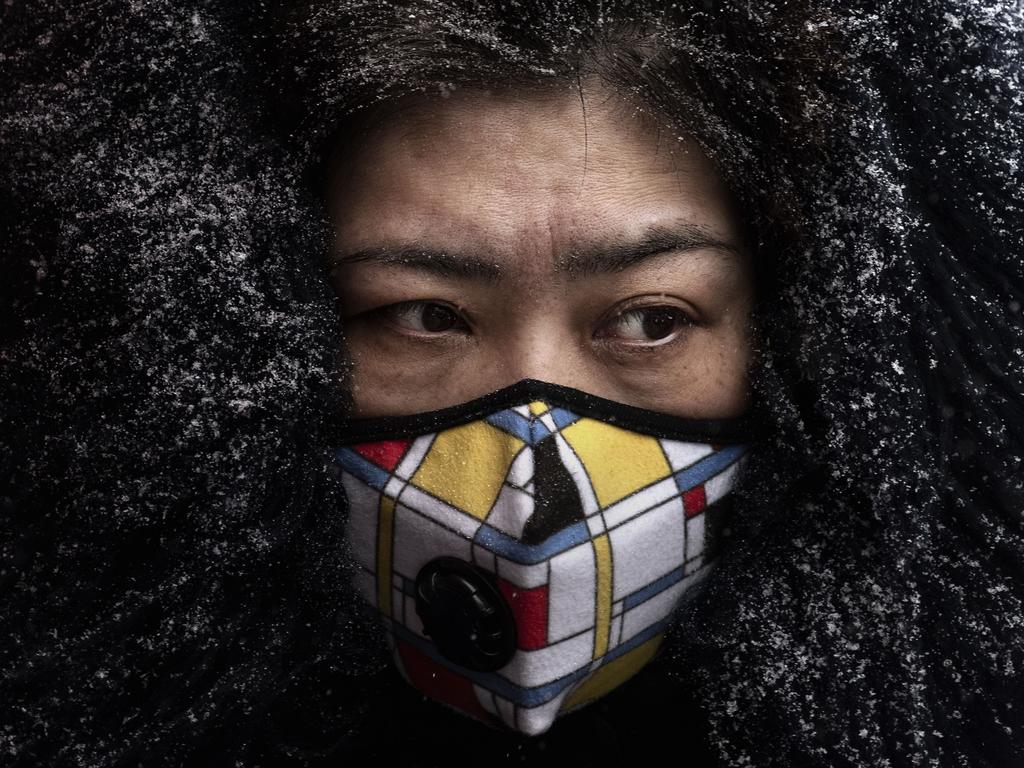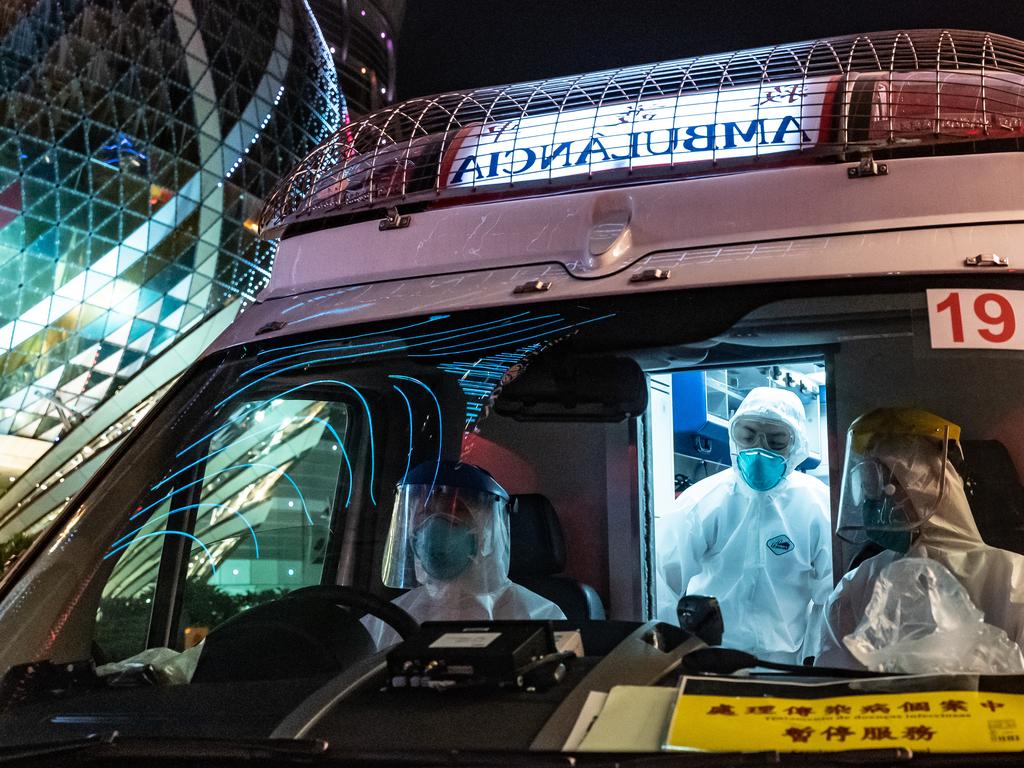Seventh medical worker dies in sign of front line strains over coronavirus
China has repeatedly insisted its deadly coronavirus outbreak is under control – but this latest move suggests the truth is dramatically different.
China is calling out its military to reinforce exhausted health workers and enforce strict new quarantine measures imposed upon the epicentre of the Covid-19 virus outbreak as a seventh medical worker dies from the disease.
On Tuesday, Wuhan’s health bureau announced hospital director Liu Zhiming died from coronavirus despite “all out” attempts to save him.
He is the seventh healthworker to die among the more than 1,700 doctors and nurses who have become sick.
The Wuhan Municipal Health Commission said Liu had made “important contributions in the work of fighting and controlling” the virus.
During that process, “unfortunately he became infected and passed away at 10:54 Tuesday morning at the age of 51 after all-out efforts to save him failed,” the commission said.
It comes as China is cautiously noting a reduction in the number of new daily cases and deaths, along with a study that shows most people who contracted the virus experienced only mild symptoms.
Communist Party leader Chairman Xi Jinping has offered his highest praise to hospital staff, calling those in Hubei province “heroes”. But, he says China must now mobilise a “people’s war” against the outbreak.
The Chinese leader is deploying thousands of troops to reinforce a medical system cracking under the strain despite repeated assertions the outbreak is under control.

TACTICAL DEPLOYMENTS
People’s Liberation Army Lieutenant General Chen Wei, a biological warfare expert, was dispatched to Wuhan at the end of January. She has experience from the fight against SARS in 2003. And she brought with her a team of experts from China’s Biological Hazards Prevention and Control Program.
Since then some 4000 military-trained doctors, nurses and orderlies have been ordered to support relief efforts, including the operation of new emergency-build hospitals.
At the weekend, General Chen was joined by Chairman Xi’s protege Chen Yixin. The Communist Party security specialist has been given responsibility for containing the outbreak to Hubei province.
Among his first acts was the isolation of some 2000 rural villages. Nobody is allowed in or out of the towns, which have just one heavily defended checkpoint to allow in food, supplies and medical help.
He’s being backed up by a fresh force of 2600 additional People’s Liberation Army (PLA) medical personnel. They’re being flown in aboard large military transport aircraft stacked with military supplies.
Exactly how much help battlefield-trained medics will be is yet to be seen.
But Hubei’s 500,000 health workers are beginning to breaking under pressure. They’ve been working around-the-clock work since mid-January under immensely challenging conditions. They’ve also proven to be dangerously susceptible to infection themselves.
RELATED: China warns of deadly new virus epicentre
RELATED: Terrifying photo of killer virus

DOCTORS DYING
The death of Dr Liu Zhiming was reported on Monday but quickly retracted, following a similar pattern to the death of Dr Wenliang which led to a huge backlash against the government on social media.
Covid-19 whistleblower Dr Li Wenliang died at the neighbouring Wuhan Central Hospital on February 7. He had been arrested after alerting fellow medicos in January to what he believed to be a new SARS-like infection.
But these are just the two highest-profile deaths among Chinese medical workers.
There have been more.

Anecdotal reports suggest an unusually high number of Hubei provinces’ 500,000 health workers have become infected. One doctor at a community clinic in Wuhan told AFP he and 16 other colleagues were showing symptoms similar to the new virus, including lung infections and coughing.
One sick nurse told Al Jazeera: “When I was admitted to the hospital, a colleague of mine burst into tears and said she was so scared and so tired. We already had at least 150 colleagues who had either confirmed or suspected to have been infected – we’re all very scared.”
A shortage of masks and protective equipment continues to compound the situation. Single-use protective gear is being reportedly re-used until it breaks, is patched up with duct-tape, and then torn beyond repair. Chinese social media posts reveal some hospital staff have resorted to wearing raincoats and garbage bags.
Beijing has admitted that, up to Tuesday last week, six health workers had died and another 1700 had the virus. This means some 3.8 per cent of all cases of Covid-19 across China are among public health staff.
No update has been issued since.
RELATED: Mystery over doctor at virus epicentre
RELATED: 58 million in virus lockdown

KILLING THE CARERS
“If we can’t protect those who are helping us at literally the worst place possible during this battle, then what good are we?” one Weibo social media post stated at the weekend.
Even the World Health Organisation, which has been outspoken in its praise of Chairman Xi’s handling of the outbreak, has expressed concern.
“This is a critical piece of information because health workers are the glue that holds the health system and outbreak response together,” WHO director-general Dr Tedros Adhanom Ghebreyesus said at the weekend.
Need to learn: what % occurred before best infxn control efforts in place, vs after?; are certain interventions, practices, PPE approaches associated
— Tom Inglesby (@T_Inglesby) February 15, 2020
w higher infxn rates? All of this info should have been released as it
was occurring, not wks later. (3/x)
Any disease that kills trained and well-protected health workers is a pandemic nightmare.
In 2003, a single SARS patient infected more than 50 health workers. In the outbreak’s early months, 5 per cent of doctors, 4 per cent of nurses and 8 per cent of health care assistants treating the disease became infected. About 1 per cent of these medicos died.
One Singapore study put part of the blame for this on poorly-fitted N95 medical masks. And mistakes made by over-fatigued specialist carers contributed heavily to the remainder.
During the 2014 ebola breakout, health workers were some 21 to 32 times more likely to become infected with the haemorrhagic disease than the population they worked within.
It decimated medical staff in Liberia and Sierra Leone.
Now, it seems Covid-19 is killing carers.
In any event, 1700 is a very large number and shows HCWs are at clear
— Tom Inglesby (@T_Inglesby) February 15, 2020
risk of infxn elsewhere in China and globally. Hosps need admin controls,
engineering controls and supplies of PPE for their HCWs caring for pts with#COVID19. (4/x)
“1700 is a very large number and shows HCWs (health care workers) are at clear risk of infxn (infection) elsewhere in China and globally,” director of Johns Hopkins SPH Centre for Health Security Tom Inglesby posted on Twitter.
Many Chinese medical workers say they are isolating themselves from their families and staying at work out of fear of infecting their loved ones. This is only adding to their fatigue.
“We are pretty much ‘naked’ in the biohazard environment,” one anonymous doctor told Al Jazeera. “It’s getting better than the first few days, of course, but the needed medical supplies are still in shortage.”
“There are risks — there simply aren’t enough resources,” a Wuhan Central Hospital administrator told the New York Times.
REINFORCEMENTS
State media is full of images of doctors and nurses, in pristine protective gear, diligently working on submissive patients. The narrative is one of heroic self-sacrifice, the leaving behind of families to commit all efforts in a valiant fight against the outbreak.
The reality is, Hubei’s doctors, nurses and orderlies are deeply fatigued after weeks of working around the clock. While quarantine measures have dispersed the initial queues, the Covid-19 caseload continues to climb.
Many experts believe it was this sudden rush to Wuhan’s biggest and best hospitals that caused such widespread cross-infection rate. Since then, the central government in Beijing has sent 180 medical teams comprising some 20,000 doctors and nurses to the city.
The PLA deployed its first batch of battlefield medics on February 13 when 1400 troops helped establish rapidly constructed new hospitals. The reinforcements currently being deployed will bring that number up to about 6000.
Meanwhile, research teams from the WHO and the US Centres for Disease Control are still barred from travelling to Hubei. Both agencies have been seeking permission to do so since January.
“Obviously, we are quite eager for the Chinese to accept the offer of the World Health Organisation and the United States to assist their scientists in this endeavour,” CDC secretary Alex Azar told NPR news.

LOCKDOWN
China’s strict censors have been allowing criticism – of local provincial leaders only – to seep into social media. The Communist Party chiefs of Hubei province and Wuhan city have been sacked. So has the province’s two top health officials.
Chairman Xi has now parachuted in his loyalists to replace them.
China must “dare to criticise” those who fail to carry out official orders, and dereliction of duty “shall be punished according to discipline and law,” Chairman Xi said in a recent speech.
But the officials he has put in place generally have backgrounds in security and the military.
Exactly what toll the virus has taken among police and military personnel enforcing the quarantine blockades has not been revealed.
But the job of containing the 58 million Chinese currently under orders to stay in their homes won’t be getting any easier as the lockdowns extend into their second month.
About 50 major cities and four provinces in China have been placed under lockdown notices.
Households within the quarantine zones are allowed to send only member out of the house every three days to obtain necessary supplies. All transport has been barred.
And then there are the 2000 Hubei province villages at the epicentre of the outbreak.

Under orders from Chairman Xi’s delegate, police and military forces have reportedly blockaded every entrance to every community, leaving just one heavily guarded checkpoint to let in food and supplies. Urban residential compounds will reportedly be similarly be isolated.
Meanwhile, Chairman Xi has said the outbreak is “a major test of China’s system and capacity for governance. Party committees and governments at all levels must firmly obey the centralised leadership of the CPC Central Committee,” he said in a speech last week.
Jamie Seidel is a freelance writer | @JamieSeidel



